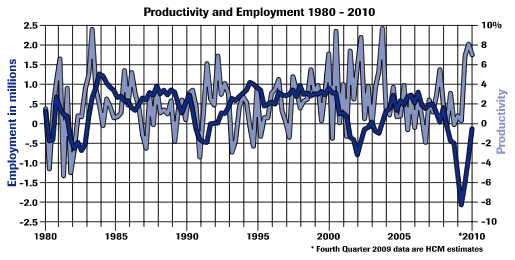2009 Q4 | 2009… A Wild Ride
 The 4th quarter was another good one for the stock market, marking its third consecutive advance. As a leading indicator for the economy, the market is signaling investors the recovery is real. Where there are still plenty of skeptics, it would appear to us the improving economic data is forming a base upon which a meaningful, sustainable economic recovery can occur.
The 4th quarter was another good one for the stock market, marking its third consecutive advance. As a leading indicator for the economy, the market is signaling investors the recovery is real. Where there are still plenty of skeptics, it would appear to us the improving economic data is forming a base upon which a meaningful, sustainable economic recovery can occur.
For the quarter, the S&P 500 returned 6.01%. You may recall the 2nd and 3rd quarters returned 15.94% and 15.56%, respectively. From the index’s trough on March 9, 2009, the S&P 500 has returned 67.8%, one of the strongest nine-month periods in the history of the index. The Dow Jones Industrial Average returned 59.8% over the same time period. For the full year 2009, the S&P 500, Dow and Nasdaq returned 26.50%, 22.60% and 43.91%, respectively. After an abysmal 2008, these results were well-received.
As the stock market began its recovery, the bond market moved in the opposite direction. In the first half of 2009, we saw interest rates move to historic lows as the government continued to work to grease the skids of the credit markets. As these programs began to have a positive effect, interest rates began moving higher. By the end of the year, those rates were much higher. The 10-year Treasury started 2009 yielding 2.20% and ended it yielding 3.79%. As you will recall, when yields rise, bond prices fall. Most Treasuries provided investors with a negative return for the year. Because of the perceived risks in Corporate and Municipal bonds during the year, their yields did not drop as much. The result for investors was that bonds produced positive returns for the year. The Barclays Corporate Index returned 5.24% for the year and the Barclay’s Municipal Index returned 7.61%.
Although we usher in the New Year and decade with optimism, many old problems continue to confront us. Perhaps the most challenging problem in the United States, and Europe for that matter, is jobs. As the media have been drilling into our heads, the unemployment rate hit a post-depression high of 10.2% in October. Yet, the November report saw the first meaningful drop in the unemployment rate since 2006. Even though the unemployment rate dropped, we have not experienced net job creation in this country since December 2007. For a sustainable economic recovery to occur, jobs need to be created. We believe that will happen in the first or second quarter of 2010.
Even though the economy is clearly improving, job recovery is not. But this is to be expected. After all, unemployment is a lagging economic indicator. In fact, it is one of the last economic series to recover because employers are reluctant to hire after a recession. Given the magnitude of this recession, it is not surprising that hiring back workers is going very slowly. But there appear to be positive signs that employment trends are beginning to turn.
First, the initial claims for unemployment insurance are well off of their highs and consistently improving almost every week. Second, the average number of hours worked in a week is improving (39.4 hours to 40.4 hours). Before companies hire new workers, they increase the hours of their existing work force. As demand for product begins to improve, companies meet the demand by asking current employees to work longer hours. Third, unsustainable productivity numbers are being achieved, creating the backdrop for hiring. The result of managing employees more efficiently is higher productivity, which leads directly to hiring. The third quarter productivity numbers were near record levels and we expect the fourth quarter to be similar. As the chart indicates, high productivity leads to higher employment.
– – – – – – – – – – – – – – – – – – – – – – – – – – – – – – – – – – – – – – – – – –
The most important piece of the economic
recovery puzzle lies with the consumer.
– – – – – – – – – – – – – – – – – – – – – – – – – – – – – – – – – – – – – – – – – –
Low inventories of just about everything from electronics to apparel to automobiles contribute to our optimism regarding this recovery. Inventories declined by 12.6% during 2009. Essentially, production stopped and inventories were allowed to be drawn down significantly. In fact, Christmas retail sales were somewhat constrained due to lower inventory levels and a major East Coast snowstorm over the key December 18-20 weekend. More importantly, promotional pricing was less prevalent than in 2008 due to the scarcity factor. Although we do not expect to see positive press on the Christmas selling season, we expect retail profitability to be surprisingly good when reported in early February.
Another positive development is exemplified by the “Cash for Clunkers” program initiated by the government to support the auto industry. Despite political sniping, the program worked—as sales of vehicles jumped 30% to a 13 million unit annual rate. Though well below the 17 million rate of 2007, it was still a welcome relief for the auto industry. Indeed, automobile inventories were cleaned out. Production schedules for General Motors are up 75% for the first quarter of 2010 and at Ford they’re up 58%. This is very good news for the 2010 economic outlook. These production schedules will have a multiplier effect on many suppliers, particularly in the Midwest, where economic conditions have been very harsh.

The most important piece of the economic recovery puzzle lies with the consumer. Nothing will truly last without the consumer spending more money. This will happen only when jobs are created and confidence returns. Absent confidence, the consumer slows spending and saves, which leads to the Paradox of Thrift, a topic we have discussed in prior newsletters. Simply put, every dollar saved is a dollar less of income for the business owner. Once the saving rate stabilizes, the consumer will begin spending again, and businesses will then increase production as there will be a need to replenish their diminished inventories. Confirmation of the economic recovery should come in the second or third quarter of 2010. With the benefit of hindsight, we feel Federal Reserve Chairman Ben Bernanke has done an excellent job of reinforcing confidence, supporting our favorable view for stocks. Having been nominated by the President for another term, we hope for, and expect, Senate approval.
As we approach the New Year, I would like to take a look back to 2009. In the early part of the year, we witnessed the ending of one of the most vicious bear markets that I’ve seen in my career. On March 9th, the Dow Jones Industrial Average closed at 6,547, down 53.4% from its October 2007 high of 14,165, exceeded only by the decline of 80% experienced during the 1929-32 correction. Yet, we survived the 2009 lows and recovered 68% by year-end. In short, there will be no depression, and the financial meltdown was contained. We made it through a very tough market. Let us be thankful as we end this decade and enter the second decade of the 21st century. If history is a guide, equity prices will regress to the mean. Suggesting, not necessarily this year, that the Dow should appreciate towards the nominal Gross Domestic Product, which should be near $15 trillion. This would equate to 15,000 on the Dow, or nearly 45% above current levels.
As we look to the future, government spending and government deficits will be a serious challenge. The deficit stands at 10% of our Gross Domestic Product. This is very high by historic standards, but the recession required strong government support in the face of the economic decline and the liquidity crisis of 2008. The economy has operated successfully with deficits of 2 to 4% of the Gross Domestic Product. That said, to trim the current level of deficit some increases in taxes may be necessary. The trick will be to reign in government spending as our economy recovers, thereby lowering the percentage of the deficit relative to the GDP. Further government stimulus programs would be unwise, unless the economy falters, which we do not expect.
– – – – – – – – – – – – – – – – – – – – – – – – – – – – – – – – – – – – – – – – – –
We think the stock market will continue to perform well in 2010.
– – – – – – – – – – – – – – – – – – – – – – – – – – – – – – – – – – – – – – – – – –
Our interest rate forecast for 2010 calls for further caution. As employment begins to pick up, it is likely that the Federal Reserve will raise interest rates. For our clients who own bonds, we do not see a great deal of value in the bond market and continue to buy shorter maturity issues. Economic recovery will ultimately bring with it higher rates and better investment opportunities. The significant federal deficits that we anticipate for the foreseeable future may adversely affect inflation as well. In addition, we continue to recommend avoiding bonds rated below investment grade.
Our equity outlook is more positive. We think the stock market will continue to perform well in 2010. Our forecast is for stocks to be up 10%-18%. This is contingent on the Fed’s ability to continue managing the economy well. Historically, the first two rate increases have not adversely impacted equity values. Beyond that, we will have to double our watch.
Finally, some of our clients have asked, “What might we expect were something to happen to you?” Good question. My intention is to continue working in a job I absolutely love. However, I have decided to begin a transition in the management of this firm. Effective February 1, 2010, Scott Murphy will become Executive Vice President of our firm so that you know there is a succession plan in place. Scott joined the firm in 1997, and is a gifted investor and administrator. In the months ahead, if you don’t know him I will introduce him to you. So, we enter 2010 with optimism for the market and our firm.
—Jim Hardesty



